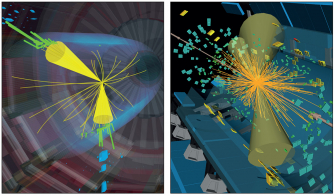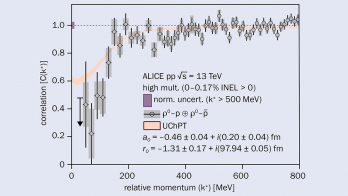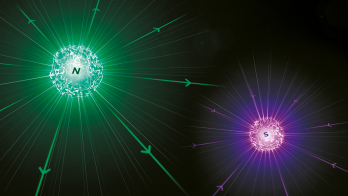Teams from France, Germany and Poland have recently observed two-proton radioactive decay from iron-45 nuclei. Bertram Blank explains how this opens up exciting new research avenues in nuclear physics.
An atomic nucleus is an ensemble of nucleons – protons and neutrons. To bind these nucleons and to form a stable nucleus, a subtle equilibrium of the number of protons and the number of neutrons is needed. For light species, a stable nucleus is formed from an equal number of protons and neutrons. Above the nucleon number A = 40, more neutrons than protons have to be added to form a stable atomic nucleus to overcome the Coulomb repulsion of the charged protons.
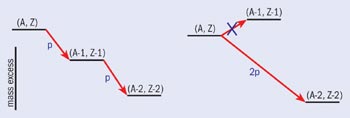
If the equilibrium between protons and neutrons is disturbed, a nucleus becomes unstable and decays; for a slight imbalance it decays by b-decay (transformation of a proton into a neutron or vice versa), whereas for a large disequilibrium it will emit nucleons. This kind of particle emission from a nucleus was first observed for heavy nuclei, which may emit a particles (helium nuclei) to gain stability. For lighter very proton-rich nuclei with an odd number of protons (Z), proton emission was observed for the first time during the early 1980s at the GSI laboratory in Darmstadt, Germany. According to theoretical predictions, simultaneous two-proton emission from nuclear ground states should occur for even-Z nuclei. This two-proton radioactivity is only observable if the sequential emission of two independent protons is energetically forbidden (figure 1). This is the case for medium-mass proton-rich nuclei around A = 40-50. Due to the gain of stability from the pairing energy, the mass of the even-Z two-proton emitter is smaller than the mass of the odd-Z one-proton daughter, and therefore one-proton emission cannot occur. The only open decay branch is simultaneous two-proton decay.
First observations
Experimental efforts have focused on the observation of this decay mode since its theoretical prediction in the 1960s, and in particular since the first observation of two-proton emission from excited states after b-decay in the 1980s. The first case of two-proton emission was that of aluminium-22, observed at Berkeley, US. However, the decay of this nucleus as well as those of all other b-delayed two-proton emitters turned out to be sequential (the decay proceeds via a well defined intermediate state in the one-proton daughter). No direct two-proton emission could be observed.
The situation is similar for the very-light, even-Z, proton drip-line nuclei beryllium-6 and oxygen-12, studied during the 1990s (a drip line is the boundary beyond which nuclei decay by proton or neutron emission). Although for these light nuclei, the intermediate one-proton daughter state may lie higher in energy than the two-proton emitting state, the sequential branch is always found open, because all the states involved are very broad, a consequence of the small Coulomb barrier for these light nuclei.
Theoretical predictions therefore pointed rather to medium-mass proton drip-line nuclei, and found iron-45, nickel-48 and zinc-54 to be the most promising candidates for direct two-proton ground-state decay. For these nuclei, the energy available for the two protons (the Q value) was found to be large enough to yield a reasonable probability for the two protons to traverse the Coulomb barrier fast enough so that two-proton radioactivity could dominate over b-decay (the competing decay), but not too large to make the decay too fast to be observed.
Following recent observations of iron-45 and nickel-48, experiments were planned to study their radioactive decay. Due to the fact that iron-45 is somewhat less exotic (less far away from stability) than nickel-48, and therefore its production rates are about an order of magnitude higher, iron-45 turned out to be the prime candidate for two-proton radioactivity. Its decay by this new type of radioactivity has now been observed in two independent experiments at the GANIL laboratory in Caen, France, and at GSI (see further reading).

Both experiments used projectile fragmentation of a stable nickel-58 beam on a beryllium (GSI) or nickel (GANIL) target. The fragments of interest were selected by a fragment separator and directed to a detection station, where the decay of iron-45 was observed after its implantation in a stack of silicon detectors. The GSI experiment identified four decays of iron-45 with decay energy of about 1.1 MeV, whereas in the GANIL experiment 12 correlated decays were measured with the same energy. The half-lives determined in both experiments agree nicely and yield an average value of about 3.8 ms. The decay energy and half-life are in beautiful agreement with theoretical predictions using a shell-model approach combined with Coulomb-barrier penetration calculations. However, the most important piece of evidence comes from the fact that both experiments looked for b particles from a possible b-decay of iron-45. In the GSI experiment, a sodium iodide barrel would have detected the 511 keV photons from annihilation of the b particles, whereas in the GANIL experiment, a silicon detector was used to observe any b particles directly. No such coincident radiation was observed for any of the events consistent with two-proton radioactivity. Therefore both experiments excluded the possibility that the 1.1 MeV decay signal of iron-45 is due to a b-delayed decay branch, the concurrent decay possibility of this nucleus.
Both experiments observed only the total energy released in the decay. Neither was designed to identify the individual protons and measure their energies and relative emission angles. However, from theoretical predictions it is clear that the emission must have taken place simultaneously. None of the commonly used models predicts any significant sequential emission branch. But even in the case of simultaneous emission, two extreme pictures can be designed. One is an emission process whereby the two protons are emitted independently and therefore fill the whole phase space (there is no particular energy or angular correlation between the two protons). This decay mechanism is usually referred to as three-body decay. The other decay mechanism is known as helium-2 emission, where the two protons are strongly correlated and one could expect an angular and/or energy correlation between them. For both pictures, theoretical descriptions are available. However, a complete model should accommodate both pictures simultaneously and describe them as extremes of a more realistic modelling of the process. These types of descriptions are now being developed, mainly in close connection with the models used for two-neutron halo nuclei on the opposite side of the valley of stability.
Testing the models
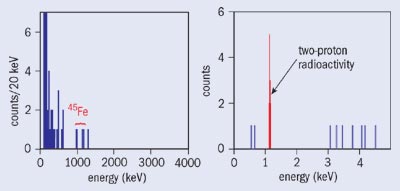
To test these models in more detail, better experimental data and more theoretical development are needed. It is of particular importance, for example, to go beyond a measurement of only the total decay energy. By measuring the individual proton energies and their relative emission angles, conclusions about the decay mechanism can probably be drawn. However, for these kinds of measurements, the silicon detection set-ups used in the GANIL and GSI experiments can no longer be used. In such set-ups, the decay protons cannot escape from the detector, and therefore no information about the individual energies and the proton-proton angles can be gained. This problem can be overcome by using gas tracking detectors, so that the tracks of the emitted protons can be observed. A development recently started at the Centre d’Etudes Nucléaires (CEN) Bordeaux-Gradignan, whereby a time-projection chamber (TPC) will be used to visualize the tracks of the two protons in three dimensions. With such a set-up, the two-proton emitter will no longer be implanted deeply into a silicon detector, but will be in the centre of a gas cell used as the active volume of the TPC.
Another research direction will be to identify new two-proton emitters. Nickel-48 and zinc-54 are especially accessible for experiments, and are ready to be studied. These investigations may then allow the decay mechanism of two-proton radioactivity to be studied. In particular, two-proton decay may open an original route towards studying pairing in the atomic nucleus. In addition, masses will be determined for nuclei beyond the limits of stability via the measurement of the two-proton Q value, which then allows mass-model predictions far away from the stability line to be tested. By comparing experimental results and theoretical calculations, the single-particle structure of extremely proton-rich nuclei might become accessible. It is commonly felt that a deeper understanding of nuclear structure can only be obtained by studying nuclei far away from stability. Two-proton radioactivity is now set to provide an interesting probe for this endeavour.






